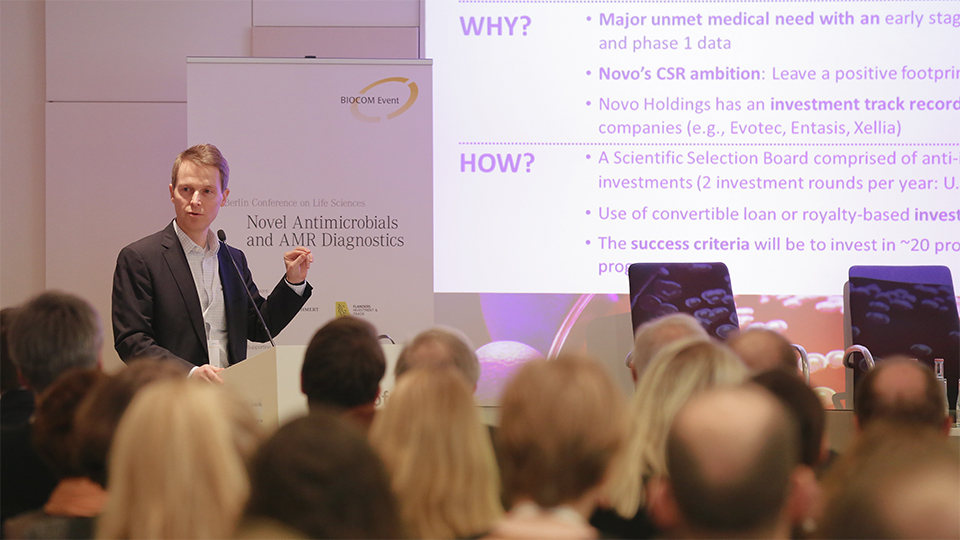
Investors keen to put money into AMR SMEs
Investments into new drugs to tackle antimicrobial resistance (AMR) are set to boost the participation of SMEs. At the 11th Berlin Conference on Life Sciences, two new financing initiatives, which focus on innovations developed by SMEs, were presented to 200+ AMR stakeholders.
Whilst the REPAIR impact fund, launched by Novo Holdings in late February, will provide €135m over the next 3-5 years as convertible loan or royalty-based funding to SME-developed new anti-infective modalities, the UNCTAD (United Nations Conference on Trade and Development) plans to help establishing an unconventional funding vehicle for SMEs in the AMR field in the long-term. In a first step, a match-making platform will be set up during the World Investment Forum 2018 (22-25 October, Geneva). As the return on investment (ROI) from antimicrobials that break resistance is limited by the need to rationally apply them, we seek to bring together SMEs with non-traditional investors, who have an economic interest in reducing treatment and hospitalisation times, said Christoph Spennemann at the event, organised by BIOCOM.
The funds were welcomed by the BEAM alliance, which published a position paper last year, that asked for more SME-specific funding. Marc Gitzinger, CEO of Bioversys, one of BEAM member companies, said that the new financing initiatives will give a push to the development of the approximately 100 pipeline projects of BEAM members. He also applauded the European Medicines Agency’s Head of Anti-Infectives and Vaccines, Mario Cavalieri, who will start talks with BEAM members about establishing novel biomarker-based endpoints to assess efficacy of novel antimicrobials in clinical trials. In a high ranking industry panel discussion, it became clear that the 50-year old test for minimal inhibitory concentration (MIC) neither is very accurate nor can it determine the efficacy of novel drug classes such as inhibitors of microbial virulence factors, which block infection without killing a pathogen. Currently, prediction of efficacy is expressed as a probability of attainment of the pharmacodynamic target (PD) and defines the MIC breakpoint, said Mark Jones, Head of Preclinical Development at Basilea Pharmaceutica. It’s crucial to establish cost-effective predicitive efficacy tests that prevent the need to test thousands of patients in clinical trials, stressed Johan Mouton, partner in the Innovative Medicines Initiatives Combacte project from University Utrecht and representative of the European Committee on Antimicrobial Susceptibility Testing (EUCAST).
In an investor panel, which discussed how to re-incentivise AMR R&D and market access including developing countries, it became clear that revival of the dried pipeline of antimicrobials does not only need mechanisms that push preclinical and clinical R&D through new initiatives such as GARPD, CARB-X, JPIAMR, IMI (ENABLE), BARDA etc. Panelist Aleks Engel, Partner at Novo Holdings, also welcomed the recommendation of the IMI’s project DRIVE-AB to establish pull mechanisms, such as an annual market entry award for approval of first-in-class antimicrobials that present the prospect of an appropriate ROI to developers.
DRIVE-AB representative Christine Årdal outlined the policy recommendations of the project, including an annual US$250 addition to the current US$550m funding of push initiatives and an annual US$400m investment aimed to provide an US$1bn market entry award to innovators who bring new classes of resistance breakers to the market. Årdal told European Biotechnology that no government wants to be the first to establish such a mechanism. Consequently, first informal talks starting this spring will take place with a group of governmental representatives. Not all stakeholders at the international conference, however, were convinced that the proposed the-first-takes-it-all approach will provide a solution to the lack of ROI as it would inhibit the development of better drugs with the same mechanism later on.
Current push initiatives include the Innovfin scheme of the European Investment Bank that has almost provided loans of €140 for eight clincial drug developers and diagnostics companies in the AMR field from its €260m budget. CARB-X has financed US$62m to 23 companies/academic research groups and optioned further US$85m for commercialisation of concepts to tackle AMR. The next funding round in Spring (submission date 22 March) will be focussed on novel direct-acting APIs against Gram-negative bugs from the WHO/CDC list of priority pathogens. Another round in June will be focussed on a broad scope of therapeutics, vaccines, diagnostics and devices. We would love to see many applications from Europe, Kevin Outterson, Executive Director from CARB-X, said in Berlin. Furthermore, GARDP and CARB-X will start a large-scale initiative (REVIVE) connecting people with AMR as well as R&D expertise in a few weeks. For companies, which want to go from hit to lead to candidate, the IMI’s €85m programme ENABLE may be an alternative: firstly, it provides a better chance to be selected (15 of 70 applications) than CARB-X (23 vs 324 applications), secondly companies are not subject to deadlines because one can apply permanently. However, all push initiatives that fund early stage innovation have to consider the high attrition rate of programmes at that stage. With ENABLE, we pave the way to find effective new drugs to fight multi-drug resistance said Anders Karlén, Leader of the managing entity at ENABLE in Berlin, and we keep our pipeline open for new Expressions of Interest from both SMEs and academia.
Following the publication of a pipeline analysis of antimicrobials undergoing clinical testing that target the 12 priority pathogens last October, the WHO is researching a list of preclinical candidates to provide an overview what’s coming next. Another goal is to coordinate resource allocation through a global R&D hub set to start its work this year in Germany. 18 governments have already given their commitment to participate, according to Andrea Spelberg, from German Research Ministry, which will coordinate the hub in the next three years.
At the meeting, Catherina Boehme, CEO of the Foundation for Innovative New Diagnostics (FIND), which recently published new funding projects, announced the set up of an essential diagnostics list at the organisation’s April meeting. Diagnostics can save patient lives, she stressed pointing to the fact that the best R&D would make no sense if there was no market access. Current FIND activities focus on establishing cheap and robust POCT tests to be used in developing countries that allow differentiation between viral and bacterial febrious infections and which could limit current antibiotics overprescription in the global South when accompanied by mass media campaigns. Israelian Memed Diagnostics Ltd presented a handheld CE-marked rapid test at the conference that differentiates between viral or bacterial pathogens by determining the molecular profile of the immune response.
Furthermore, a series of promising pipeline therapeutics and diagnostics (Curetis) were presented at Berlin Conference, including an approach that delivers an antibiogramm based on bacterial growth few hours after inoculation of blood cultures and a theranostic approach to combat septic shock. Several drug developers (Oppilotech Ltd, Vaxdyn SL, AGILebiotix BV, Phagomed Biopharma GmbH) and diagnostics companies (Spindiag GmbH, Resistell, FASTinov AS) presented their platforms and new concepts in a start-up pitch. Phagomed, which is set to establish bacteriophage-based antibacterial strategies, was the winner of the conferences’ Start-up pitch. For more information on the technology, please see the next print issue of European Biotechnology Magazine, which will cover current phage therapies, an interview with Aleks Engels and George Griffin, Chair of the REPAIR Impact Fund’s SAB, and an editorial from Christoph Spennemann.



 Photo from Shawn Day on Unsplash
Photo from Shawn Day on Unsplash 